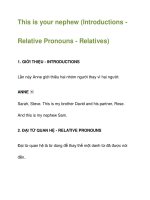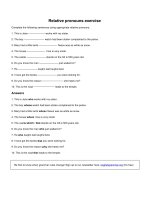Conjunctions and relative pronouns
Bạn đang xem bản rút gọn của tài liệu. Xem và tải ngay bản đầy đủ của tài liệu tại đây (13.74 KB, 2 trang )
Conjunctions and relative pronouns
A conjunction is merely a connecting word. In English, we require just one
conjunction
to connect two clauses.
Conjunctions join together sentences and often make them more compact.
For example, the sentence
‘Maya and Swati are good dancers
’ is a short way of saying
‘Maya is a good
dancer and Swati is a good dancer’.
The sentence
‘She is poor, but honest’
is a contracted way of saying
‘She is poor but she is honest’.
Sometimes the conjunction ‘and’ merely joins two or more words together.
Examples are given below.
Two and two make four.
Ram and Laxman are brothers.
Oil and water do not mix.
Such sentences cannot be resolved into two. For example, we can’t say:
Ram is a brother and Laxman is a
brother.
Conjunctions must be carefully distinguished from
relative pronouns, relative adverbs and prepositions
which
are also connecting words.
Study the examples given below.
This is the house
that
my grandfather built in 1960.
Here the relative pronoun that connects the two clauses:
This is the house.
My grandfather built it in 1960.
Another example is given below.
This is the house
where
my parents live.
Here the relative adverb ‘where’ connects the two clauses:
This is the house.
My parents live here.
Now study the following example.
He is ill but he is cheerful.
Here the conjunction ‘but’ merely connects the two clauses:
He is ill.
He is cheerful.
A
preposition
also joins two words, but it does much more that. A preposition governs a noun or pronoun and
shows its relationship with another word or words in the sentence.
She sat
beside
her mother.
Here the preposition ‘beside’ governs the noun ‘mother’ which acts as its object.
Be first to know when grammar rules change! Sign up to our newsletter here: englishgrammar.org (It's free)
Powered by TCPDF (www.tcpdf.org)









